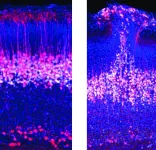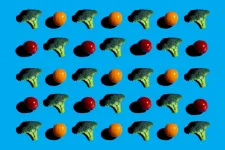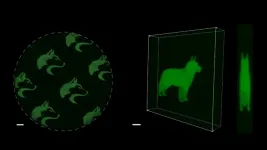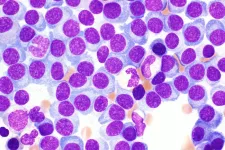(Press-News.org) COLUMBUS, Ohio – Researchers have made huge strides in ensuring that red blood cell substitutes – or artificial blood – are able to work safely and effectively when transfused into the bloodstream.
The key is to make the artificial blood molecules big enough so they don’t leak from blood vessels into tissue and cause dangerous cardiovascular side effects, notes a new study led by researchers from The Ohio State University.
Although blood loss is typically treated by transfusing units of donated blood, in cases where transfusions aren’t readily available or time is too limited to screen for patient blood type compatibility (such as in certain rural areas or on the battlefield), artificial blood products offer medical professionals more flexibility for treatment. In clinical trials, previous generations of these blood substitutes often resulted in several poor health outcomes, as individuals experienced symptoms ranging from narrowing of blood vessels and high blood pressure to tissue injury.
In this study, researchers found that a certain sized fraction of red blood cell substitute can provide a range of health benefits, and can decrease the risk of cardiovascular side effects – if its components are the right size.
“We found that as you make the red blood cell substitute molecules bigger, you have fewer side effects,” said Alisyn Greenfield, lead author of the study and a PhD student in chemical and biomolecular engineering at Ohio State. “There’s even a particular size range that has better benefits when it comes to the kind of cardiovascular effects that were seen with with previous generations of this material.”
Their findings were published in the journal Biomacromolecules.
The researchers tested a red blood cell substitute called polymerized human hemoglobin – PolyhHb. Although past commercial versions have been explored in clinical settings, they did not receive FDA approval due to their many side effects.
To find a better solution, the team focused on identifying a target therapeutic size of PolyhHb by synthesizing material in four different-sized brackets and exploring the cardiovascular response in guinea pig models. Findings showed that the largest-sized brackets did not escape the blood vessels, or cause the blood vessels to narrow and elicit high blood pressure.
Study senior author Andre Palmer, professor of chemical and biochemical engineering at Ohio State, said the antioxidant status of guinea pigs is more similar to humans than other rodents, making them a good model for the study.
While these red blood cell substitutes aren’t meant to replace blood entirely, this research highlights the potential of these materials. If transfused into a person soon after injury, they could be used to buy the person enough time to be transported to a medical facility to receive a blood transfusion, said Palmer.
Additionally, because blood substitutes aren’t made with any surface antigens or markers on the outside of the red blood cell’s membrane, they can be transfused into anyone, regardless of their blood type. That said, artificial blood is still a long way from commercialization.
Even though it can be stored at room temperature for several years compared to the 42-day storage period for donated blood, artificial blood doesn’t come close to replicating the lifetime of real blood cells, said Palmer. Once produced, a typical red blood cell circulates in the human body for a period of about 120 days, yet the materials in current blood substitutes are made with only a half-life of about 24 hours after administration.
Further study is needed to more accurately determine the red blood cell substitute’s safety and efficacy in clinical settings. “By performing this study, we demonstrated that we can improve upon what currently exists and, hopefully, be able to move our research forward and translate those materials into the clinic,” said Greenfield.
This study was supported by the National Institutes of Health. Other Ohio State co-authors were Xiangming Gu, Ahmad Yahya, Amid Vahedi and Mohd. Asim Khan. Other co-authors came from the University of Maryland.
#
Contact: Alisyn Greenfield, Greenfield.89@buckeyemail.osu.edu
Written by: Tatyana Woodall, Woodall.52@osu.edu
END
Leaps in artificial blood research aim to improve product safety, efficacy
Scientists finds protein size regulates cardiovascular side effects
2023-04-17
ELSE PRESS RELEASES FROM THIS DATE:
Ye receives funding for collaborative research: Ri: Small: Motion Field Understanding for Enhanced Long-Range Imaging
2023-04-17
Jinwei Ye, Assistant Professor, Computer Science, received funding from the National Science Foundation for the project: "Collaborative Research: RI: Small: Motion Field Understanding for Enhanced Long-Range Imaging."
Ye is collaborating with Nianyi Li, Assistant Professor of Computer Science at Clemson University, and Suren Jayasuriya, Assistant Professor, Arts Media and Engineering, and Assistant Professor, School of Electrical, Energy and Computer Engineering, at Arizona State University.
As ...
VA, NIH launch study of Gulf War Illness
2023-04-17
The Department of Veterans Affairs (VA) and National Institutes of Health have launched a study to gain a better understanding of the chronic symptoms of Gulf War Illness. The disease affects multiple systems in the body and includes chronic symptoms such as fatigue, headache, memory and cognitive difficulties, joint and muscle pain, poor sleep, and problems with gastrointestinal and respiratory function. It affects about a third of the nearly 700,000 men and women who served in the Persian Gulf during operations Desert Shield and Desert Storm.
“This is an important collaboration that we hope will lead to many answers to those ...
The 411 on marijuana use and cardiovascular health ahead of 4/20 Day
2023-04-17
DALLAS, April 17, 2023 — Legalization of marijuana, for both medical and recreational use, is on the rise across the U.S. The American Heart Association, the world’s leading nonprofit organization focused on heart and brain health for all, warns that using marijuana may increase your risk of deadly cardiovascular diseases, heart attacks and strokes, according to research evidence noted in two scientific statements published by the Association.
The Association’s 2020 scientific statement Medical Marijuana, Recreational Cannabis, and Cardiovascular Health, ...
Researchers discover a new embryonic brain circuit
2023-04-17
EMBARGOED UNTIL 17-APR-2023 11:00 ET
Basel, April 17, 2023 Using a new approach for studying live embryonic mouse brains at single-cell resolution, researchers have identified an active multi-layer circuit that forms in the cortex during an unexpectedly early stage of development. Perturbing the circuit genetically led to changes similar to those seen in the brains of people with autism. The findings are reported today in Cell by a team based at the Institute of Molecular and Clinical Ophthalmology Basel.
“Understanding the detailed development of cell types and circuits in the cortex can provide ...
Study links poor diet to 14 million cases of type 2 diabetes globally
2023-04-17
A research model of dietary intake in 184 countries, developed by researchers at the Friedman School of Nutrition Science and Policy at Tufts University, estimates that poor diet contributed to over 14.1 million cases of type 2 diabetes in 2018, representing over 70% of new diagnoses globally. The analysis, which looked at data from 1990 and 2018, provides valuable insight into which dietary factors are driving type 2 diabetes burden by world region. The study was published April 17 in the journal Nature Medicine.
Of the 11 dietary factors considered, three had an outsized contribution to the rising global incidence of type 2 diabetes: ...
SpyLigation uses light to switch on proteins
2023-04-17
Scientists can now use light to activate protein functions both inside and outside of living cells. The new method, called light-activated SpyLigation, can turn on proteins that are normally off to allow researchers to study and control them in more detail. This technology has potential uses in tissue engineering, regenerative medicine, and understanding how the body works.
Proteins perform nearly every important task in biology, including processing DNA, metabolizing nutrients, and fighting off infections. When, where, and how proteins become active is important for a variety of biological processes. Increasingly, ...
Dexamethasone for inpatients with COVID-19 in a national cohort
2023-04-17
About The Study: In this national multicenter cohort study of inpatients with COVID-19, early administration of dexamethasone was associated with significantly reduced odds of mortality or discharge to hospice in those requiring supplemental oxygen or mechanical ventilation and/or extracorporeal membrane oxygenation but not in those requiring no supplemental oxygen or noninvasive positive pressure ventilation. These results support the continued use of systemic dexamethasone in patients hospitalized with COVID-19.
Authors: Laine ...
Investigational drug may improve stem cell transplantation for multiple myeloma patients
2023-04-17
The standard treatment for patients with multiple myeloma often includes stem cell transplantation in which the patient’s own stem cells are harvested and stored while the patient receives intensive chemotherapy to kill the cancer. Then, the patient’s stem cells are returned to the patient to help with recovery. But for a significant proportion of patients, the number of stem cells that can be harvested is not optimal for transplant and negatively affects patient outcomes.
However, an international phase 3 clinical trial led by physicians at Washington University School of Medicine in St. Louis has shown that the investigational ...
University of Rochester researchers discover how to steer army of immune cells toward cancer
2023-04-17
Immunotherapy, particularly CAR T-Cell treatment for cancer, is extending the lives of many patients. But sometimes the therapy randomly migrates to places it shouldn’t go, tucking into the lungs or other noncancerous tissue and causing toxic side effects. A University of Rochester/Wilmot Cancer Institute team discovered the molecule responsible for guiding T cells toward tumors, setting the stage for scientists to improve upon the groundbreaking treatment.
The next step is to find a drug that can manipulate the ...
Poverty is the fourth greatest cause of U.S. deaths, analysis published in JAMA finds.
2023-04-17
Poverty has long been linked to shorter lives. But just how many deaths in the United States are associated with poverty? The number has been elusive – until now.
UC Riverside paper published Monday in the Journal of the American Medical Association associated poverty with an estimated 183,000 deaths in the United States in 2019 among people 15 years and older.
This estimate is considered conservative because the data is from the year just prior to the COVID-19 pandemic, which caused spikes in deaths worldwide and continues to take its toll.
The analysis found that only heart disease, ...
LAST 30 PRESS RELEASES:
Sleeping in on weekends may help boost teens’ mental health
Study: Teens use cellphones for an hour a day at school
After more than two years of war, Palestinian children are hungry, denied education and “like the living dead”
The untold story of life with Prader-Willi syndrome - according to the siblings who live it
How the parasite that ‘gave up sex’ found more hosts – and why its victory won’t last
When is it time to jump? The boiling frog problem of AI use in physics education
Twitter data reveals partisan divide in understanding why pollen season's getting worse
AI is quick but risky for updating old software
Revolutionizing biosecurity: new multi-omics framework to transform invasive species management
From ancient herb to modern medicine: new review unveils the multi-targeted healing potential of Borago officinalis
Building a global scientific community: Biological Diversity Journal announces dual recruitment of Editorial Board and Youth Editorial Board members
Microbes that break down antibiotics help protect ecosystems under drug pollution
Smart biochar that remembers pollutants offers a new way to clean water and recycle biomass
Rice genes matter more than domestication in shaping plant microbiomes
Ticking time bomb: Some farmers report as many as 70 tick encounters over a 6-month period
Turning garden and crop waste into plastics
Scientists discover ‘platypus galaxies’ in the early universe
Seeing thyroid cancer in a new light: when AI meets label-free imaging in the operating room
Neutrophil-to-lymphocyte ratio may aid risk stratification in depressive disorder
2026 Seismological Society of America Annual Meeting
AI-powered ECG analysis offers promising path for early detection of chronic obstructive pulmonary disease, says Mount Sinai researchers
GIMM uncovers flaws in lab-grown heart cells and paves the way for improved treatments
Cracking the evolutionary code of sleep
Medications could help the aging brain cope with surgery, memory impairment
Back pain linked to worse sleep years later in men over 65, according to study
CDC urges ‘shared decision-making’ on some childhood vaccines; many unclear about what that means
New research finds that an ‘equal treatment’ approach to economic opportunity advertising can backfire
Researchers create shape-shifting, self-navigating microparticles
Science army mobilizes to map US soil microbiome
Researchers develop new tools to turn grain crops into biosensors
[Press-News.org] Leaps in artificial blood research aim to improve product safety, efficacyScientists finds protein size regulates cardiovascular side effects




